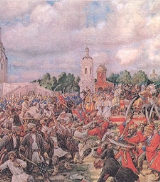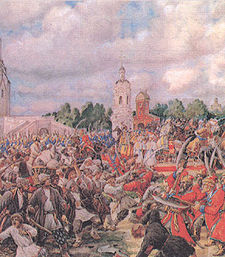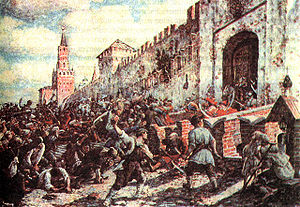
Salt Riot
Encyclopedia

Riot
A riot is a form of civil disorder characterized often by what is thought of as disorganized groups lashing out in a sudden and intense rash of violence against authority, property or people. While individuals may attempt to lead or control a riot, riots are thought to be typically chaotic and...
in Moscow
Moscow
Moscow is the capital, the most populous city, and the most populous federal subject of Russia. The city is a major political, economic, cultural, scientific, religious, financial, educational, and transportation centre of Russia and the continent...
in 1648, triggered by the government's substitution of different taxes
Tax
To tax is to impose a financial charge or other levy upon a taxpayer by a state or the functional equivalent of a state such that failure to pay is punishable by law. Taxes are also imposed by many subnational entities...
with a universal direct salt tax
Salt tax
A salt tax is literally a tax levied directly on salt, usually proportional to the amount of salt purchased . In ancient times, salt was extremely valuable as a preservant, and, in some cultures, nearly worth its weight in gold. Words such as salary are derived from the same root as salt and...
for the purpose of replenishing the state treasury
Treasury
A treasury is either*A government department related to finance and taxation.*A place where currency or precious items is/are kept....
, which, in turn, made salt a much more expensive commodity.
The beginning of the Salt Riot
The indignation of peasantPeasant
A peasant is an agricultural worker who generally tend to be poor and homeless-Etymology:The word is derived from 15th century French païsant meaning one from the pays, or countryside, ultimately from the Latin pagus, or outlying administrative district.- Position in society :Peasants typically...
s and townsfolk forced the government to abolish this new way of taxation, but the previous arrears
Arrears
Arrears is a legal term for the part of a debt that is overdue after missing one or more required payments. The amount of the arrears is the amount accrued from the date on which the first missed payment was due...
, however, were being collected for the past three years all at once. On 1 June 1648, upon Alexei I
Alexis I of Russia
Aleksey Mikhailovich Romanov was the Tsar of Russia during some of the most eventful decades of the mid-17th century...
's return to Moscow from his trip to Troitse-Sergiyeva Lavra
Troitse-Sergiyeva Lavra
The Trinity Lavra of St. Sergius is the most important Russian monastery and the spiritual centre of the Russian Orthodox Church. The monastery is situated in the town of Sergiyev Posad, about 70 km to the north-east from Moscow by the road leading to Yaroslavl, and currently is home to...
, a crowd of townspeople surrounded the tsar
Tsar
Tsar is a title used to designate certain European Slavic monarchs or supreme rulers. As a system of government in the Tsardom of Russia and Russian Empire, it is known as Tsarist autocracy, or Tsarism...
and complained about the boyar
Boyar
A boyar, or bolyar , was a member of the highest rank of the feudal Moscovian, Kievan Rus'ian, Bulgarian, Wallachian, and Moldavian aristocracies, second only to the ruling princes , from the 10th century through the 17th century....
s and prikaz
Prikaz
Prikaz was an administrative or judicial office in Muscovy and Russia of 15th-18th centuries. The term is usually translated as "ministry", "office" or "department". In modern Russian "prikaz" means administrative or military order...
officials. The royal bodyguard
Bodyguard
A bodyguard is a type of security operative or government agent who protects a person—usually a famous, wealthy, or politically important figure—from assault, kidnapping, assassination, stalking, loss of confidential information, terrorist attack or other threats.Most important public figures such...
s started dispersing the crowd, pushing them away from the tsar. This caused a major outbreak of anger among the people. On 2 June, most of the Streltsy
Streltsy
Streltsy were the units of Russian guardsmen in the 16th - early 18th centuries, armed with firearms. They are also collectively known as Marksman Troops .- Origins and organization :...
joined the rebelling citizens. The insurgents burst into the Moscow Kremlin
Moscow Kremlin
The Moscow Kremlin , sometimes referred to as simply The Kremlin, is a historic fortified complex at the heart of Moscow, overlooking the Moskva River , Saint Basil's Cathedral and Red Square and the Alexander Garden...
and demanded the surrender of Leontiy Pleshcheyev (head of Zemsky Prikaz and Moscow police department), Duma
Duma
A Duma is any of various representative assemblies in modern Russia and Russian history. The State Duma in the Russian Empire and Russian Federation corresponds to the lower house of the parliament. Simply it is a form of Russian governmental institution, that was formed during the reign of the...
diak Nazar Chistoy (salt tax initiator), boyar Boris Morozov
Boris Morozov
Boris Ivanovich Morozov was a Muscovite statesman and boyar who led the Russian government during the early reign of Tsar Alexis, whose tutor and brother-in-law he was....
(actual head of government) and his brother-in-law Pyotr Trakhaniotov (head of Cannon Prikaz). The tsar was forced to surrender Leontius Pleshcheyev to the people on 3 June, who would be soon executed. The rebels set fire to the White City
Bely Gorod
Bely Gorod is the central core area of Moscow, Russia. The name comes from the color of its defensive wall, which was erected in 1585-1593 at the behest of tsar Feodor I and Boris Godunov by architect Fyodor Kon...
and Kitai-gorod
Kitai-gorod
Kitay-gorod , earlier also known as Great Posad , is a business district within Moscow, Russia, encircled by mostly-reconstructed medieval walls. It is separated from the Moscow Kremlin by Red Square. It does not constitute a district , as there are no resident voters, thus, municipal elections...
and sacked some 70 household
Household
The household is "the basic residential unit in which economic production, consumption, inheritance, child rearing, and shelter are organized and carried out"; [the household] "may or may not be synonymous with family"....
s of the most hated boyars, diaks, okolnichy
Okolnichy
Okolnichy was an old rank and a position at the court of Moscow rulers from the Mongol invasion of Rus' until the government reform undertaken by Peter the Great...
s, and merchant
Merchant
A merchant is a businessperson who trades in commodities that were produced by others, in order to earn a profit.Merchants can be one of two types:# A wholesale merchant operates in the chain between producer and retail merchant...
s, killing Nazar Chistoy. Pyotr Trakhaniotov tried to escape, but was soon apprehended and executed on 5 June.
The second phase of the riot

Kirillo-Belozersky Monastery
Kirillo-Belozersky Monastery , loosely translated in English as the St. Cyril-Belozersk Monastery, used to be the largest monastery of Northern Russia. The monastery was dedicated to the Feast of the Dormition of the Theotokos, for which cause it was sometimes referred to as the Dormition Monastery...
on 11 June. After that, the uprising gradually began to fade away, partly because of the ravaging fire
Fire
Fire is the rapid oxidation of a material in the chemical process of combustion, releasing heat, light, and various reaction products. Slower oxidative processes like rusting or digestion are not included by this definition....
s. Soon, however, the provincial nobility, big merchants, and top posad
Posad
A posad was a settlement, often surrounded by ramparts and a moat, adjoining a town or a kremlin, but outside of it, or adjoining a monastery in the 10th to 15th centuries. Usually it was inhabited by craftsmen and merchants, known as posadskiye lyudi .In the Russian Empire a posad was a small...
people seized the initiative and came out with a petition
Petition
A petition is a request to do something, most commonly addressed to a government official or public entity. Petitions to a deity are a form of prayer....
demanding the convocation of the zemsky sobor
Zemsky Sobor
The zemsky sobor was the first Russian parliament of the feudal Estates type, in the 16th and 17th centuries. The term roughly means assembly of the land. It could be summoned either by tsar, or patriarch, or the Boyar Duma...
, salary distribution, increase of time limits for search of the runaway peasants etc. These demands, however, were very narrow in their scope and were aimed at the reinforcement of serfdom
Russian serfdom
The origins of serfdom in Russia are traced to Kievan Rus in the 11th century. Legal documents of the epoch, such as Russkaya Pravda, distinguished several degrees of feudal dependency of peasants, the term for an unfree peasant in the Russian Empire, krepostnoi krestyanin , is translated as serf.-...
without meeting the needs of other categories of people. Upon Morozov's removal, a new anti-Morozov boyar group came to power, led by Prince Yakov Cherkassky and boyar Nikita Romanov
Nikita Romanov
Nikita Ivanovich Romanov was a son of Ivan Romanov and a cousin of Tsar Michael. He was the last Romanov of an unroyal line.-Life:...
. They began distributing money and lands to the dvoryane and made a few concessions to the remaining rebels, including the postponement of collection of arrears on 12 June. The government’s measures widened the split among the rebels, and soon many of the leaders of the uprising were arrested and executed on 3 July. On 22 October, Boris Morozov was summoned to Moscow and appointed head of the Russian government yet again.
The end of the riot
Sporadic rebellions, triggered by the Salt Riot in Moscow, continued to take place throughout RussiaRussia
Russia or , officially known as both Russia and the Russian Federation , is a country in northern Eurasia. It is a federal semi-presidential republic, comprising 83 federal subjects...
, but they would all die down by January of 1649 with the adoption of the Sobornoye Ulozheniye
Sobornoye Ulozheniye
The Sobornoye Ulozheniye was a legal code promulgated in 1649 by the Zemsky Sobor under Alexis of Russia as a replacement for the Sudebnik of 1497 introduced by Ivan III of Russia, which is based, among others, on the Third Statute of Lithuania...
(Legal Code), which satisfied most of the demands posed by the nobility.

